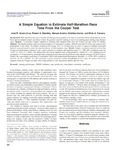A Simple Equation to Estimate Half-Marathon Race Time From the Cooper Test

Use este enlace para citar
http://hdl.handle.net/2183/40676
Excepto si se señala otra cosa, la licencia del ítem se describe como Atribución-NoComercial-SinDerivadas 4.0 International
Colecciones
- Investigación (CCDEF) [297]
Metadatos
Mostrar el registro completo del ítemTítulo
A Simple Equation to Estimate Half-Marathon Race Time From the Cooper TestAutor(es)
Fecha
2020-05-30Cita bibliográfica
Alvero-Cruz, J. R., Standley, R. A., Giráldez-García, M. A., & Carnero, E. A. (2020). A Simple Equation to Estimate Half-Marathon Race Time From the Cooper Test. International Journal of Sports Physiology and Performance., 15(5), 690–695. https://doi.org/10.1123/ijspp.2019-0518
Resumen
[Abstract]: Background: Half-marathon races have become increasingly more popular with many recreational athletes all around the world. New and recreational runners are likely to have the greatest need for training advice to set running paces during long-distance races. Purpose: To develop a simple equation to estimate half-marathon time from the Cooper test and verify its validity. Methods: One hundred ninety-eight recreational runners (177 men and 21 women, 40 [6.8] years and
33.7 [8] years, respectively) participated in this study. All runners completed the Cooper test 7 to 10 days prior to races. A stepwise multiple regression analysis was performed to select the main predictors of half-marathon time. Results: Simple correlation analysis showed that Cooper test performance (distance) was a good
construct to estimate half-marathon time (r = − 95% confidence interval, −to − P <.0001). The authors also derived an equation with a high predictive validity (R<sup>2</sup> =.82; standard error of estimation = 5.19 min) and low systematic bias (mean differences between the predicted value and the criterion
of 0.48 [5.2] min). Finally, the concordance coefficient of correlation (.9038) and
proportional bias analysis (Kendall τ = − 95% confidence interval, − to
0.00453; P =.09) confirmed a good concurrent validity. Conclusion: In this study, the authors derived an equation from the Cooper test data with a high predictive and concurrent validity and low bias. ABSTRACT FROM AUTHOR
Palabras clave
Running performance
PRESS validation
Pace prediction
Concordance correlation coefficient
Rendimiento de la carrera
Validación PRESS
Predicción de ritmo
Coeficiente de correlación de concordancia
PRESS validation
Pace prediction
Concordance correlation coefficient
Rendimiento de la carrera
Validación PRESS
Predicción de ritmo
Coeficiente de correlación de concordancia
Descripción
Sports Medicine School of the University of Malaga
Versión del editor
Derechos
Atribución-NoComercial-SinDerivadas 4.0 International
ISSN
1555-0273






